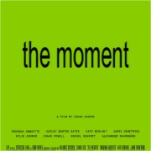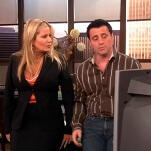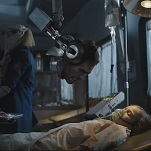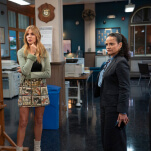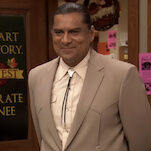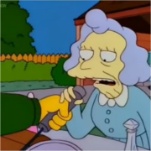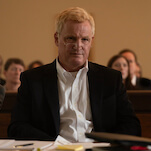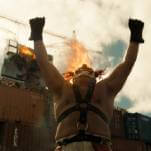In 1971, Mike Leigh emerged from the world of experimental theater to direct Bleak Moments, the first of many exquisitely detailed dramas about contemporary working-class British life. During a long stint making films for the BBC, Leigh refined a radical technique for developing scripts which involved his actors creating their characters (including entire personal histories) through rigorous improvisation. But it wasn't until High Hopes in 1988 that his work received much attention elsewhere. With a remarkable streak of critically revered work throughout the '90s—including Life Is Sweet, Naked, Secrets & Lies, and Career Girls—Leigh has since taken his place among the world's premier filmmakers. His latest, Topsy-Turvy, is an unexpected and delightful period piece about the original staging of Gilbert & Sullivan's The Mikado at The D'Oyly Carte Theatre, benefiting from his customary attention to the tiniest minutiae of character and setting. Jim Broadbent and Allan Corduner star as William Gilbert and Arthur Sullivan, respectively, the pair behind such Victorian-era operettas as The Pirates Of Penzance and HMS Pinafore. Leigh recently spoke to The Onion A.V. Club about his films and his unique approach to making them.
The Onion: After three decades of films about contemporary working-class life, Topsy-Turvy is in obvious ways a departure. Why Gilbert & Sullivan and why at this point in your career?
Mike Leigh: Why at this point in my career? Well, I don't really think of what I'm doing as a career, exactly. I think you can have a career as a doctor or a lawyer, but not as a filmmaker. But why at this stage in my activity? At this stage, I kind of felt, for no intellectual reasons, that it was time to do a film about us, which is to say a film about people who do the sorts of things that I do: making popular art and hoping people will laugh, but still taking it seriously. I felt I wanted to do a period film, and I have always had an interest in the 19th century, which is not like the 14th century; it's not remote. I grew up in the '40s and '50s in the very Victorian city of Manchester, exposed to Victorian architecture, Victorian literature, and so on. So all of that is there and Gilbert & Sullivan were part of it. Why Gilbert & Sullivan? I just think they're interesting themselves, and what's fascinating is them in relation to this period. I thought it would be good to take this sort of chocolate-box subject and subvert it by taking it seriously.
O: Could you describe the research process for this picture
ML: Yeah, the actual research was… well, research. You name it, we did it. We read everything, we accessed all the resources, we talked to any number of experts, we researched the social etiquette of the people at the time, we researched the original staging of the musical sequences, we researched politics, education, and so on. Everybody had to be involved in it, because the task was to bring that whole world to life. The development of my scripts is very organic and my job is to distill all of this information.
O: Considering your organic methods for formulating a script, how were you able to accept the actors' contributions to the dialogue while still keeping it authentic to the period?
ML: Well, that's just the name of the game. In a way, the premise of the question is slightly faulty—no disrespect—because the actors are all just as involved in the research as everybody else. My films are about character acting and, in this case, the actors drew very specifically on their research to create their characters. Since I obviously work with highly talented and intelligent and sophisticated actors, the problem of their contribution being in any way at odds with the research wasn't really an issue because they were on a wavelength with the whole process. My job was to get everyone to breathe the same air and talk the same language, so the question you're asking was never a cause for concern.
O: Well, I ask because it just seems like the period language is such a different ballgame than contemporary dialogue.
ML: Yes, but whichever of my films you've seen, what you're seeing are people, again, not just playing themselves, not just exercising their egos, but actually doing somebody with a considerable amount of care and consideration into the nature of the project. There's always some kind of research involved. For example, David Thewlis [as the street philosopher in Naked] read everything the guy had read. Therefore, it becomes a positive and sophisticated collaboration, rather than me being stuck with childlike, stupid actors who keep fucking it all up because they don't know how to do it right. It isn't their territory. It's grown-ups doing sophisticated work.
O: Since the film deals so thoroughly with the creative process, did you see it as a reflection of your own methods?
ML: I don't really see it as a reflection of my own methods as such, except in certain moments. For example, Grossmith [an egomaniacal actor played by Martin Savage] affects a cockney accent and Gilbert says, "What are you doing?" He says, "I'm a cheap tailor, I thought it would be…" and Gilbert says, "Nonsense! We're in Japan, not [London]. Do it properly!" [Laughs.] Of course, that is such nonsense anyway, because they're interpreting Japanese in English terms. Grossmith is probably right, really. So, in the sense that that's a kind of wry joke on my part about the paradox of what I'm concerned with, which is absolute verisimilitude, then it is a reflection. In the general sense, yes, the film is about people struggling with the creative process. But in specific terms, it isn't really a reflection of me and how I do it. In fact, the struggle that Gilbert and Sullivan have about the nature of the work and the nature of truth is, quite frankly, unrelated to what I do because I don't have that conflict. I'm liberated: I enjoy the great luxury of having a sense of harmony about being able to deal in a serious way with the real world, the world that Sullivan feels he wants to address but just can't.
O: There are very few films that follow a work, as this one does, from inspiration to fruition. Did you have any past models in mind?
ML: Yeah. I tend to react a different way to [other films], like, "We're not going to do that." One of the films we were certainly not going to mimic was one made in 1953 called The Story Of Gilbert & Sullivan with Robert Morley and Maurice Evans. In general terms, there were a number of things that I was absolutely resolute about. The first and foremost of those is that I get sick of films about artists that go to great lengths to show their suffering and lack of inspiration, but you never actually find out what they did. Without question, in Topsy-Turvy, like it or not, you will get a good dose of Gilbert & Sullivan's stuff. Take it or leave it, that's what this film is going to deal with. We're going to do it properly, we're going to take it seriously, and we're not going to be coy about it. And the other thing I decided not to do… A lot of discussion and communication between Gilbert and Sullivan was done by letter. They wrote to each other several times a day; in fact, there are something like 16 collections of their correspondence. Using the telephone for chatter hadn't quite happened yet. Sewn, hopefully invisibly, into the dialogue in a couple of scenes—one with them on the sofa together and another in D'Oyly Carte's office—there are direct quotes from their correspondence, because I was determined that one thing that wasn't going to happen were letters being read out loud. [Laughs.] That's a real turkey thing to do in a movie. But as to films that were inspiring, there are the great theatrical movies: Les Enfants Du Paradis [Children Of Paradise] would have to be one; Day For Night is another in a way. And Jean Renoir's French Cancan. But I don't think there was any one film I was especially thinking of.
O: In the past, you've mentioned a certain affinity for classical Japanese cinema. Did that inform your decision to choose The Mikado instead of another operetta?
ML: The decision wasn't really founded on that premise, because the more important question was, "What was interesting?" If you go to make a film about Gilbert & Sullivan and you have to choose what would be the most interesting story to tell, of the various moments I could have dropped in on them, that seemed to me the right period. That's why I didn't want to do a biopic as such. I wanted to drop anchor just in one place and stay there, which is how I like to tell stories anyway. And what you get in that period is the impasse when [their collaboration] is cracking up, an impasse that was eventually solved by the making of The Mikado. What is fascinating and awful about the genesis of the piece was that these Dutchmen actually did go to Japan, pulled out men, women, and children—many without exit permits—and shipped them over to London for something like 53 days. They stored them in this hall near what is now the Imperial College and used them for this cultural exhibition. We didn't know much about it initially, but when we did some research, we found out that Kabuki Theater was part of the exhibition. And I thought, "God, yes! Fantastic!" Because that would help influence Gilbert. So, to answer your question, it wasn't so much because of Japanese cinema that we chose The Mikado, but once we were making it, it was a great gas to think, "Hey, we're making a Japanese movie here." In fact, there was a moment when I was working with the Japanese actors in the film—and I worked with them the same way I do everyone else; they're all London-based actors—and doing these improvisations in this dark basement for about two and a half hours, pretending that they were in this ship on this journey from Yokohama to London. And I just sat on the floor in a corner, watching them act in character, and I thought, "Wow, I'm making an Ozu film here." So, yes, it's all in the mix, but there are very few surface references.
O: Family issues have always played a central role in your work, but here they're not so explicit. Could you talk about how they might apply to the film?
ML: Yes. A close analysis of the film does reveal that some of the usual preoccupations are there. The relations between men and women, the questions of having children or not having children… They're all lurking about in there. What we do deal with, certainly with greater depth than most biographers, is Gilbert and his family and his parents and sisters. So I wouldn't say that issues of family are entirely absent from Topsy-Turvy, even if they're not at the fore.
O: What about the dynamic between Gilbert and Sullivan in the film? They don't really spend a lot of time together.
ML: No, they didn't and they don't. They didn't socialize very much. They called each other by their surnames. They didn't meet in person very often; their work was circulated by other means. There is evidence that at certain stages, Sullivan found Gilbert's behavior overbearing, though I didn't particularly see fit to explore that in any detail. They were opposites. Sullivan, as a composer, did his best work as a response to Gilbert's material. He composed some stuff on his own that was quite nice on the whole, but it was much the same kind of music he wrote with Gilbert, only more serious. He had an aspiration to be a serious composer and was exhorted to be so from a very early age, but his greatest talents were for working in tandem with Gilbert and he resented it.
O: Would you consider Topsy-Turvy your most difficult production to mount?
ML: I don't know the answer to that one. I mean, each film has its own problems. Naked was tough. Secrets & Lies was a very elaborate logistical thing, because with all of my films except Topsy-Turvy, there's a very strict code of secrecy that's upheld until the end of the shoot, so the actors don't know anything that their characters wouldn't already know going into a particular scene. With Secrets & Lies, it was especially essential that very major facts were protected from the actors. For example, when we shot one scene on the West End when Hortense [played by Marianne Jean-Baptiste] was simply coming out of a cinema and walking through the crowds, we had to make sure that everybody else in the film was not in the West End that night. It sounds silly to describe it, but those things create problems. Even Career Girls had its problems because it takes place in two different periods, and that created technical problems. Having said that, piling into a real theater in Richmond on a blazing hot day in August with a lot of people wearing kimonos and wigs under film light… There's a whole new set of problems to deal with.
O: Are there limits that you set on yourself as far as stylizing your films?
ML: Yes, but to be honest, to a great extent it comes naturally. I'm not an eclectic filmmaker who does a lot of different sorts of films. That happens to a degree, but they're all living in the same genre, even if Topsy-Turvy heads into somewhat new territory. So the style is intuitive, though I do make obvious decisions that I share with the designer and, above all, the cinematographer. With Naked, there's a definite sense of the feel and the look and the palette that had to be decided beforehand, which is similar to what had to be done with Topsy-Turvy in relation to picture reference and period look. But also, the style has to inform and not distract from the language and the behavior and the plot.
O: The structure of Topsy-Turvy is surprising and different, with these occasional flashforwards to the performance [of The Mikado].
ML: Yeah, I struggled with the structure. The only problem with flashforwards is whether the audience will buy into the conventions of it. But there's no other way of doing it. Unless you see each number as it's being discussed, what do you have? If you don't do any of that until you get to the end, you either have all the bits at once—which is boring—or you don't have anything to show. But it worked out very well. In fact, two of my favorite "buzz" moments come as a result of the flashforwards. One is after the scene when Gilbert brings the Japanese women to the rehearsal [of "Three Little Maids From School"] and we cut to the actual performance. That's a good, succulent cinematic moment. And the other is similar: At the end of the argument about the corsets [in which Grossmith complains to the costume designer about not being able to perform without one], it cuts to the pizzicato introduction to "A Wand'ring Minstrel I." That's good. That gets a buzz out of me every time. [Laughs.]


















